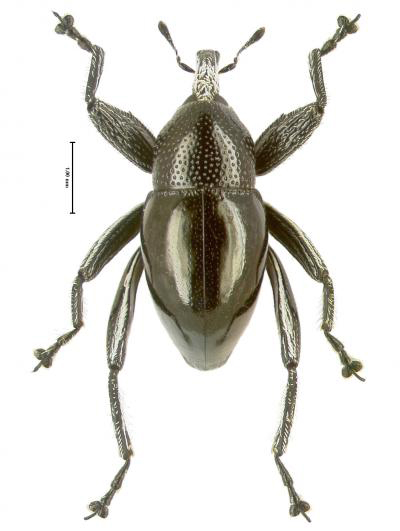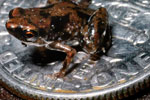In a single paper, a team of researchers have succinctly described 101 new species of weevils from New Guinea, more than doubling the known species in the beetle genus, Trigonopterus. Since describing new species is hugely laborious and time-intensive, the researchers turned to a new method of species description known as ‘turbo-taxonomy,’ which employs a mix of DNA-sequencing and taxonomic expertise to describe species more rapidly.
“When faced with a large number of morphologically similar, undescribed species, it is not an option to carry on ‘business as usual’ and
prepare very detailed descriptions with an output of only few species per year,” the researchers write in a the paper describing the new species in ZooKeys. “Such a strategy will not achieve a sustained success within this century.”
As New Guinea’s rainforest habitats disappears to a sudden rash of monoculture plantations, logging, roads, mining, and big industrial projects, scientists are racing to describe and document species that could quickly vanish altogether.
Lead author, Alexander Riedel, notes that the new method of taxonomy made the process around five times faster than traditional species description.
 New species: Trigonopterus moreaorum. Photo by: Alexander Riedel. |
“A portion of each weevil species’ DNA was sequenced, which helped to sort out and diagnose species efficiently. Besides, we have taken high-resolution photographs of each weevil that will be uploaded to Species ID, along with a short scientific description,” he explains in a press release.
While many of the new species’ morphology (physical appearance) is very similar, they are distinguished by their reproductive organs and DNA.
But how do you name so many new species?
“We propose a solution by naming ten species based on family names found in the phonebook of Papua New Guinea,” the scientists write. The new species were named after popular surnames in Papua New Guinea such as Trigonopterus moreaorum (after Morea) or Trigonopterus wariorum (after Wari).
In addition to Papua New Guinea, Trigonopterus weevils are also found on Sumatra, Samoa, the Philippines, and New Caledonia. This genus of beetles is also known for sporting the only biological screw joint found in animals: some of the species have hips with a nut-and-screw joint which experts say may help the beetles’ climb and steady themselves. Scientists believe many more of these beetles remain undiscovered.
Although Papua New Guinea is considered by many to be among the most wild places left on Earth, a 2008 study found that a quarter of the country’s forests were lost or degraded by logging between 1972-2002. The situation has only worsened as Papua New Guinea has handed vast tracts of community land to foreigners through Special Agricultural and Business Leases (SABLs). The controversial practice was halted in 2011, but not before 5.1 million hectares—an area the size of Costa Rica—were handed over largely to foreign corporations.

New species: Trigonopterus echinus. Photo by: Alexander Riedel.
CITATION: Riedel A, Sagata K, Surbakti S, Tänzler R & Balke M (2013) One hundred and one new species of Trigonopterus weevils from New Guinea. Zookeys , 280: 1. doi: 10.3897/zookeys.280.3906
Related articles
Could the Tasmanian tiger be hiding out in New Guinea?

(05/20/2013) Many people still believe the Tasmanian tiger (Thylacinus cynocephalus) survives in the wilds of Tasmania, even though the species was declared extinct over eighty years ago. Sightings and reports of the elusive carnivorous marsupial, which was the top predator on the island, pop-up almost as frequently as those of Bigfoot in North America, but to date no definitive evidence has emerged of its survival. Yet, a noted cryptozoologist (one who searches for hidden animals), Dr. Karl Shuker, wrote recently that tiger hunters should perhaps turn their attention to a different island: New Guinea.
New Guinea singing dog photographed in the wild for the first time
(12/03/2012) A rarely seen canine has been photographed in the wild, likely for the first time. Tom Hewitt, director of Adventure Alternative Borneo, photographed the New Guinea singing dog during a 12-day expedition up a remote mountain in Indonesian Papua. Very closely related to the Australian dingo, the New Guinea singing dog, so named for its unique vocalizations, has become hugely threatened by hybridization with domesticated dogs.
‘National scandal:’ foreign companies stripped Papua New Guinea of community-owned forests

(07/30/2012) Eleven percent of Papua New Guinea’s land area has been handed over to foreign corporations and companies lacking community representation, according to a new report by Greenpeace. The land has been granted under controversial government agreements known as Special Agricultural and Business Leases (SABLs), which scientists have long warned has undercut traditional landholding rights in the country and decimated many of Papua New Guinea’s biodiverse rainforests. To date, 72 SABLs have been granted—mostly to logging companies—covering an area totaling 5.1 million hectares or the size of Costa Rica.
Photo: New ‘bumblebee’ gecko discovered in New Guinea
(04/18/2012) Researchers from the Papua New Guinea National Museum and the U.S. Geological Survey have discovered a new species of gecko on an island off the coast of New Guinea.
Police hired by loggers in Papua New Guinea lock locals in shipping containers

(04/16/2012) Locals protesting the destruction of their forest in Papua New Guinea for two palm oil plantations say police have been sent in for a second time to crack-down on their activities, even as a Commission of Inquiry (COI) investigates the legality of the concession. Traditional landowners in Pomio District on the island East New Britain say police bankrolled by Malaysian logging giant Rimbunan Hijau (RH) have terrorized the population, including locking people in shipping containers for three consecutive nights. The palm oil concessions belongs to a company known as Gilford Limited, which locals say is a front group for RH.
Papua New Guinea halts controversial nickel mine – for now
(04/16/2012) A massive, controversial nickel mine has been shut down in Papua New Guinea due to the environmental concerns of its slurry pipeline, reports Cultural Survival. Inspections of the 83 mile (134 kilometer) slurry pipeline found that it had been built too close to a major highway with spills already impacting traffic. Built by the Chinese state company Metallurgical Construction Corporation (MCC), the Ramu Nickel Mine has been plagued by land issues, labor disputes, and environmental concerns.
New book series hopes to inspire research in world’s ‘hottest biodiversity hotspot’

(01/17/2012) Entomologist Dmitry Telnov hopes his new pet project will inspire and disseminate research about one of the world’s last unexplored biogeographical regions: Wallacea and New Guinea. Incredibly rich in biodiversity and still full of unknown species, the region, also known as the Indo-Australian transition, spans many of the tropical islands of the Pacific, including Indonesia’s Sulawesi, Komodo and Flores, as well as East Timor—the historically famous “spice islands” of the Moluccan Archipelago—the Solomon Islands, and, of course, New Guinea. Telnov has begun a new book series, entitled Biodiversity, Biogeography and Nature Conservation in Wallacea and New Guinea, that aims to compile and highlight new research in the region, focusing both on biology and conservation. The first volume, currently available, also includes the description of 150 new species.
New frog trumps miniscule fish for title of ‘world’s smallest vertebrate’

(01/12/2012) How small can you be and still have a spine? Scientists are continually surprised by the answer. Researchers have discovered a new species of frog in Papua New Guinea that is smaller than many insects and dwarfed by a dime. The frog trumps the previously known smallest vertebrate—a tiny fish—by nearly 1 millimeter.